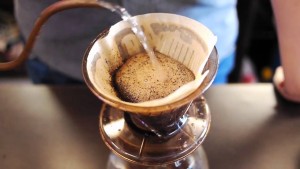The Advanced Teaching of hand-made Coffee: easy to master hand-made Coffee

For professional baristas, please follow the coffee workshop (Wechat official account cafe_style)
People who are just beginning to know hand-brewed coffee are often frightened by a dazzling array of utensils and precautions, and they don't know where to start with kettles and filter cups. In fact, different hand brewing conditions have their own advantages and disadvantages, and everyone's preferences are also different. rather than comparing the different opinions of various experts everywhere, we suggest that you understand the principle of hand-brewing coffee in order to really know how to brew a cup of coffee that suits your taste.
The special flavor of coffee
The principle of making coffee by hand
The so-called brewing coffee is actually the process of extracting the molecules from the coffee cells, and this process includes the following three steps: wetting, dissolution, and release, which occur one after another and interact with each other, and finally produce the special flavor of coffee. We will explain the following one by one:
Step 1: get wet
Literally, coffee powder gets wet when it touches water, which is the starting point when coffee cells begin to release molecules.
It should be noted that roasted coffee beans are filled with carbon dioxide, and the fresher the beans, the more carbon dioxide they contain. When the hot water touches the coffee powder, the carbon dioxide will run out first, forming a layer of air bubbles on the surface, and you will see the coffee powder in the filter cup begin to expand (pictured below). At this time, the coffee cell is like a supermarket that a lot of people have to squeeze out of the inside, and people outside can't get in at all-in the same way, hot water outside the cell can't get into the cell. Therefore, after wetting the coffee powder, we will stop injecting water and wait for the complete release of carbon dioxide and the coffee powder to stop expanding and then continue to heat the water in order to achieve a better extraction effect.
When the hot water touches the coffee powder, carbon dioxide will run out first, forming a layer of air bubbles on the surface.
Step 2: dissolve
Refers to the process of dissolving soluble molecules in coffee cells in hot water, which is the most important step in deciding to extract the flavor of coffee.
Coffee beans 2/3 are made up of insoluble cellulose and 1/3 are soluble odor molecules that are dissolved in order according to the size of the molecules when they come into contact with water. The first small molecules dissolved include acidity and aroma, then the sweetness of middle molecules, and finally the bitter taste of macromolecules, which is where the different levels of coffee taste come from. Therefore, if you like the sweeter taste, the extraction time should be shorter, because the longer the hot water stays on the coffee powder, the more bitter molecules will be dissolved.
Step 3: diffusion
After the odor molecules dissolve, they leave the coffee cells by osmosis, a process called diffusion. After the odor molecules are diffused into hot water, the final coffee extract is formed.
Coffee extraction
Factors affecting hand-brewed coffee
Once you understand the principle, you should be able to understand the effect of different hand-brewing conditions on the flavor of coffee. All the different factors actually revolve around one core: extraction time, that is, the time when coffee powder reacts with hot water. We have sorted out some important factors below:
Uniformity of coffee powder particles: the extraction speed of fine coffee powder is fast, while that of coarse coffee powder is slow, and the complete extraction time is different. If the powder particles are not uniform, it is possible that the fine coffee powder has begun to release bitter molecules, and the coarse coffee powder has not been extracted completely, resulting in a poor flavor of the final coffee. If the coffee powder is evenly granulated, there will be no such problem.
Coffee powder particle size: the finer the coffee powder, the longer the hot water will flow through the coffee powder.
Filter paper thickness: the thicker the filter paper, the slower the flow rate of the extract, and the longer the interaction between hot water and coffee powder.
Water injection speed and method: water injection is uniform and stable, so that the extraction speed of coffee powder is the same. In addition, the height of water injection will also affect the water temperature, so it is recommended to get as close to the filter cup as possible and inject water by repeated loops. (photo source: reddit)
Water temperature: the higher the water temperature, the faster the extraction speed. It is generally recommended that the deep-roasted coffee beans should be boiled at 90 degrees 80muri, while the lightly roasted coffee beans should be boiled at 90Mui 97 degrees.
Most of these factors are not standard, because everyone likes the taste of coffee is different, how to adjust different factors, rush out their favorite taste, is the most interesting part of hand-brewed coffee. For example, if you want to drink bitter coffee, you can use finer coffee powder, higher water temperature, or longer water injection time to achieve the desired taste.
Important Notice :
前街咖啡 FrontStreet Coffee has moved to new addredd:
FrontStreet Coffee Address: 315,Donghua East Road,GuangZhou
Tel:020 38364473
- Prev

An introduction to the teaching of hand-brewing coffee: the basic knowledge of hand-brewing coffee
Professional baristas Please follow the coffee workshop (official Wechat account cafe_style) in recent years, hand-brewed coffee has gradually become popular in Taiwan. In the era when all kinds of coffee machines are springing up everywhere, hand-brewing coffee with simple utensils and hand-feeling skills is like a clear stream of going back to nature, expanding from Japan, which pursues exquisite culture, so that many coffee experts and people of life are
- Next

Teaching practice of hand-brewing coffee: how to make coffee by hand at home
Exchange of professional baristas Please follow the coffee workshop (Wechat official account cafe_style) hand-brewed coffee after learning the background, then is the implementation. Here are the detailed steps and precautions for hand-brewed coffee: grind coffee beans: the standard particle size is like No. 2 sugar, can be adjusted, the key point is that the particles should be uniform, you can first use a sieve to put the ultra-fine powder
Related
- What is the meaning of lactic acid fermentation with coffee bean treatment?
- How to judge the state of foam by sound?
- How does the latte pull out the unicorn pattern? Come to get for a little trick to improve the flower pull!
- Will flower pulling affect the taste of the latte?
- Do you know the history of coffee?
- The difference between honey treatment and sun washing what is raisin honey treatment?
- What kind of milk can a novice use to make coffee foam to keep the foam longer? The correct method and skills of milking tutorial sharing
- Why do washed coffee beans taste sour? Flavor characteristics of washed Coffee
- Introduction to the skill of how to practice the size and height of water injection around the circle of hand-brewed coffee
- How do beginners practice coffee flower drawing from scratch?

